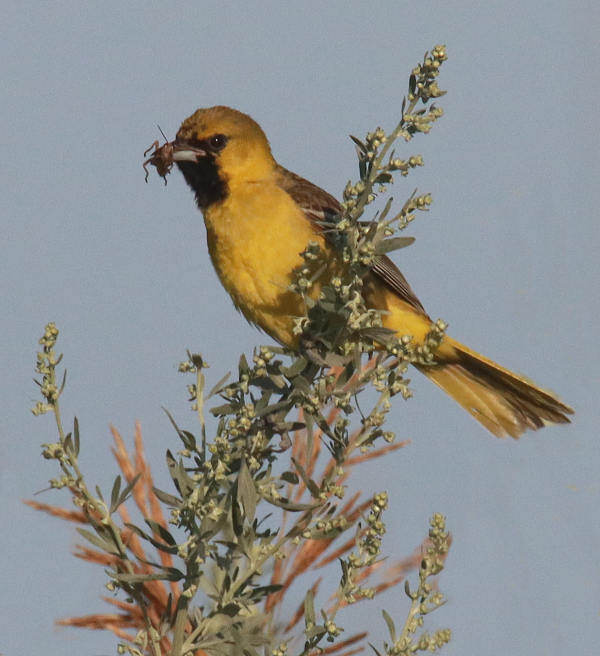
A yearling male Orchard Oriole was actively bringing insects to fledglings in the buffaloberry bush.
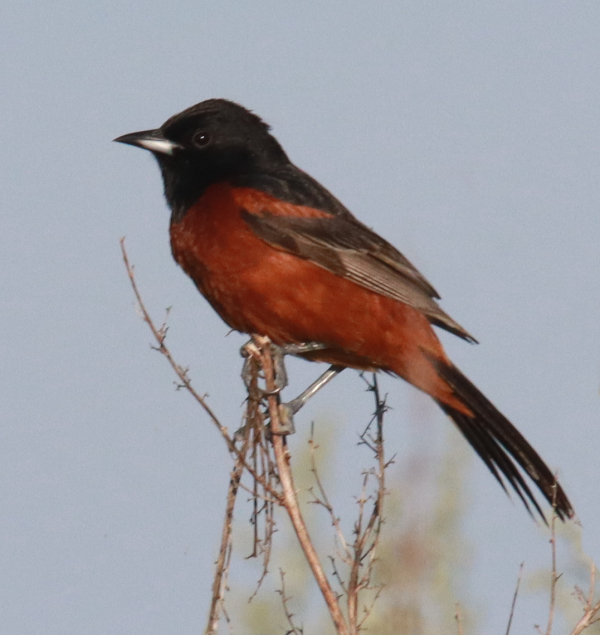
Dramatically different in color from the yearling above, an adult male Orchard Oriole was among a variety of birds active in the grasslands surrounding the buffaloberry magnet.
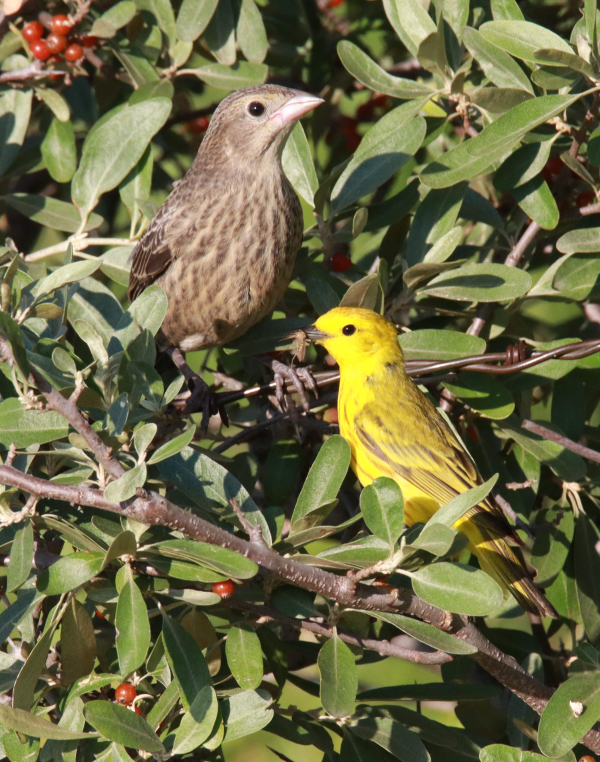
It was interesting to see a vivid example of a male Yellow Warbler feeding a fledgling Brown-headed Cowbird among the buffaloberry vegetation.
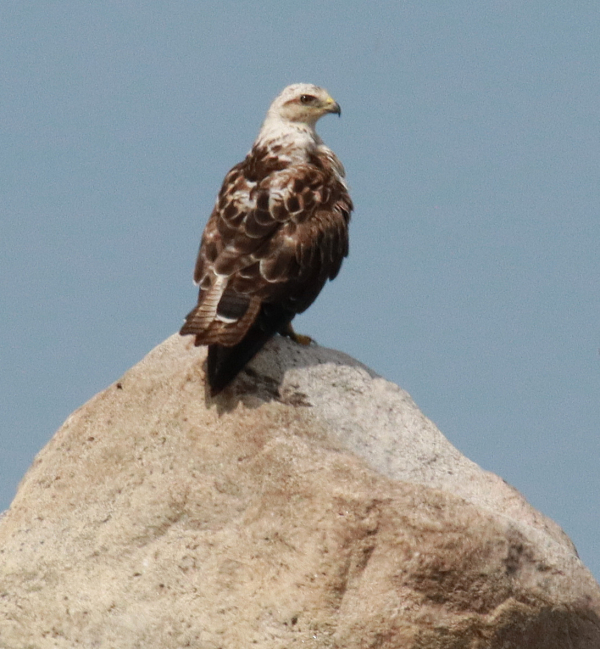
An unusually colored Swainson’s Hawk showed mostly white head and underside plumage, later identified as a characteristic of some yearling Swainson’s.

The “white-headed” Swainson’s Hawk perched on a dramatically stacked pile of boulders on a hilltop.
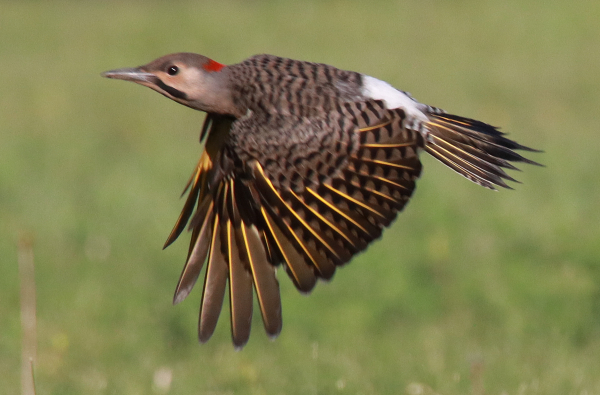
One of a brood of fledgling Northern Flickers shows its yellow-shafted wing and tail feathers vividly in flight.

Last Saturday the large female Ferruginous Hawk provided a better chance to take photographs of her in flight as she banked into the low sunlight – creating one of Paul’s favorite raptor images. This photo is also used to illustrate the second article in this issue with 2 other photos of the regal Ferrug.
|
There is a lot of avian action surrounding my area, yard, and region, but I first I want to share a First State Sighting for me, that is a First Yard Sighting too – a Carolina Wren that I observed Sunday on the trunk of one of the mature elm trees in my front yard! I grabbed my camera and photographed it for documentation, then followed its movements to the ground, on to the elm tree next to my feeding station, then to sumac branches, to a lattice opening, back to the sumacs, then gone. I watched and listened, and continue to be on alert, just in case the Carolina Wren returns.
When I checked eBird records, they showed that this is only the Third Documented Record of a Carolina Wren in North Dakota! Although there have been 7 previous sightings of a Carolina Wren reported, 5 were not documented, which underlines the importance of making photography an integral part of our birding experiences. And that was not the only rare bird sighting I had over the weekend! Saturday afternoon, during a very productive birding drive I sighted an interesting hawk perched near the road as I drove through Hawk Valley, about 15 miles west of home. This hawk appeared to be a Krider’s Red-tailed Hawk, judging by its white head that I saw while driving past it at 50mph; but I needed to get a better look at the hawk to check its I.D. and try for a photo.
Before I could get turned around, a huge cattle truck streamed by the hawk, flushing it. Seeing the hawk in flight did give me another view of the raptor though, showing its white head and breast, but its tail feathers were dark gray-brown. A Krider’s Red-tail would have mostly white-colored tail feathers, so this was more likely and off-colored Swainson’s Hawk. When the hawk perched, it looked a bit like a smaller version of an adult Bald Eagle – a hawk-sized white-headed raptor (but without a white tail).
There were 3 Swainson’s Hawks and 1 Red-tail scattered nearby to compare this bird to, attracted to the area by the activities of ranchers who were raking and baling prairie grasses they cut previously in the field where the white-headed hawk was now perched atop a tall stack of boulders on a hilltop. An adult Swainson’s Hawk that was soaring nearby zipped in to perch on a adjacent boulder, and to see the 2 together it was quite clear that the white-headed hawk was also a Swainson’s Hawk, especially when I viewed the tail feathers through 10x binoculars.
That’s when it became a question of: Was this a partial-albino (leucistic) Swainson’s, or was it a yearling Swainson’s that was molting into adult plumage? So photo-documenting the hawk with the unusual white head became all the more important, and after taking a few long-range photographs from the edge of the field, the younger of the 2 ranchers, Trae, stopped baling for a moment to check in with me. Trae approved my interest in walking into the field to get a little closer photograph after I filled him in on the Swainson’s and Red-tailed Hawks he and his Dad were attracting with their haying activities.
I don’t usually walk in on a bird such as this, but at that moment, it seemed key to getting documentary photos of the unique raptor. I walked into the open prairie field indirectly toward the 2 hawks perched on the rather picturesque stack of boulders. Fully expecting the hawks would be on alert, they actually appeared uninterested as I stepped closer, raising my camera to photograph periodically. In fact, the white-headed Swainson’s Hawk preened a bit, showing its lack of concern, then even spreading its wings wide toward the sunshine like a vulture or a cormorant does, with the normally colored Swainson’s following suit, but only in a half-hearted way. All the better for photos I figured, glad to see their lack of concern, but at that point I decided to back away and leave the raptors to hunt rodents disrupted by the haying activities.
In this case it was important to take documentary photos of the white-headed hawk to get a better look at the images that I could enlarge on my computer screen, but also to share with an authority in the field of raptor identification. After I sent the best photos with an explanation to my friend and associate William Clark, who has written a number of raptor identification books, Bill replied, “It is not uncommon for yearling Swainson's Hawks to have whitish heads.” Mystery solved.
Continuing on my birding drive, a variety of duck broods came into view as I checked some of the best waterfowl areas to the east, and in addition to new and growing broods of 7 species, I found 2 newly hatched broods of ducklings with hens from new species. First a brood of 6 chocolate-brown downy Lesser Scaup, and a little later a brood of 9 downy American Wigeon ducklings, which increased my summer list of duck species with broods in the area up to 9 different species. An interesting recent observation has been the mixing of broods, sometimes broods of different species and different ages, sometimes with the females appearing to mingle the broods for extended periods.
During a trip to Fargo last Wednesday to visit my nieces and nephews, I also checked for American Kestrels in the suburban location where I photographed them the previous week. Although I didn’t manage to take any kestrel photos, I did see 3 kestrels in the immediate area at one time, so the family group was still active in their post-fledging area. At the same time, I observed the activity of Gray Partridges, with 1 male acting especially territorial toward a female, repeatedly chasing her quite a distance on the run. During a short survey of the area where I have observed partridges for almost 2 years, I saw 3 pairs of adults with broods.
South of my office, near my friend Herb’s farm I checked a familiar buffaloberry bush where grassland songbirds concentrate about this time of the year. By parking near the mature bush I enjoyed chances to photograph several young Orchard Orioles, at least 1 adult female and male, a yearling male Orchard Oriole, and Dickcissels, Eastern Kingbirds, American Robins, Western Kingbirds, and Red-winged Blackbirds that perched on the buffaloberry bush over a half-hour’s time. I also had the chance to photograph a male Yellow Warbler feeding a Brown-headed Cowbird fledgling, a product of a female cowbird laying an egg in the smaller warbler’s nest.
Bobby’s Bay continues to attract a variety of shorebirds, with numbers and species composition changing by the hours most days. But there haven’t been any new species recently. But the real attraction during the past couple weeks has been the duck broods, beginning with the huge Gadwall brood, still numbering 19 growing ducklings. There are also a number of Blue-winged Teal broods, a Mallard brood that looks like they are full-grown, and a small Northern Pintail brood of just 3 ducklings. The ducks are usually associated with the southwest side of Bobby’s Lake, but they have been resting along the shore of the Bay more often lately.
Uncommon in the area during mid-summer, I found a family group of Northern Flickers that included 5 fledglings feeding in a mowed grass area on the edge of a farm that is surrounded by well-established trees. When I checked back a few days later, a family group of 4 American Kestrels was chasing one another in spirited flights, with some or all of them being recent fledglings. It just goes to show that even a small woodland habitat in the midst of open grasslands and farm fields can attract different nesting species, not unlike the small towns in the region that provide areas of suburban woodland habitat measuring a half a square mile, or more or less. Songbirds, flycatchers, swallows, and other species including use area farm woodlots and small town tree communities in similar fashion.
Feeder Facts
Friday evening the first fledgling robin from the second nesting attempt in my front yard followed an adult to my feeding station, where it quietly checked things out until the adult fed it. It is a beauty, darker colored than the other fledglings that have visited, and it already has grown quite a bit after leaving the nest. Robins and House Finches are both feeding fledglings in tree branches adjacent to my feeding station now, but how about the orioles? Actually, Monday afternoon an Orchard Oriole in pretty, new plumage arrived and found its way to the larger, more stable bowl that contains grape jelly for it to eat – Hooray!
Two male Orchard Orioles were momentarily present at the feeders Friday afternoon as I worked, 1 leaving as the other arrived. Saturday morning 2 males were present at the same time, and 1 even ate from a cut orange, a first since May migration. Females were much more low energy last week, even resting in adjacent branches, suggesting they are no longer frantically feeding nestlings or fledglings. Perhaps the realization that at least 1 fledgling is feeding at one of my jelly feeders is testament to that suggestion.
No sign of a Baltimore Oriole last week, or Gray Catbirds, but at least 1 male Ruby-throated Hummingbird continues to make almost daily visits to my feeding station, usually near the end of the day. Just as I see in the field, new birds should begin to show in my yard – just like the Carolina Wren, an extreme case of a New Species arriving after the nesting season. Stay alert, enjoy the birds of summer, and share your enthusiasm for birding with others – Best Wishes!
Article and Photos by Paul Konrad
Share your bird sightings and photographs at editorstbw2@gmail.com